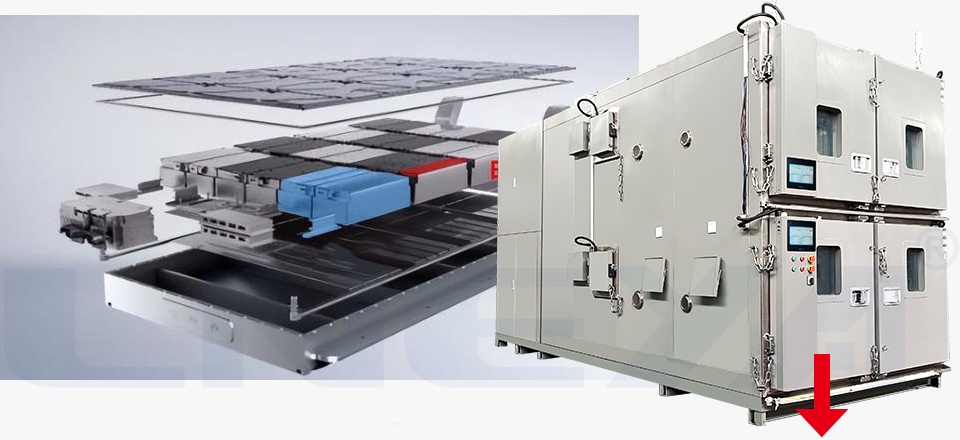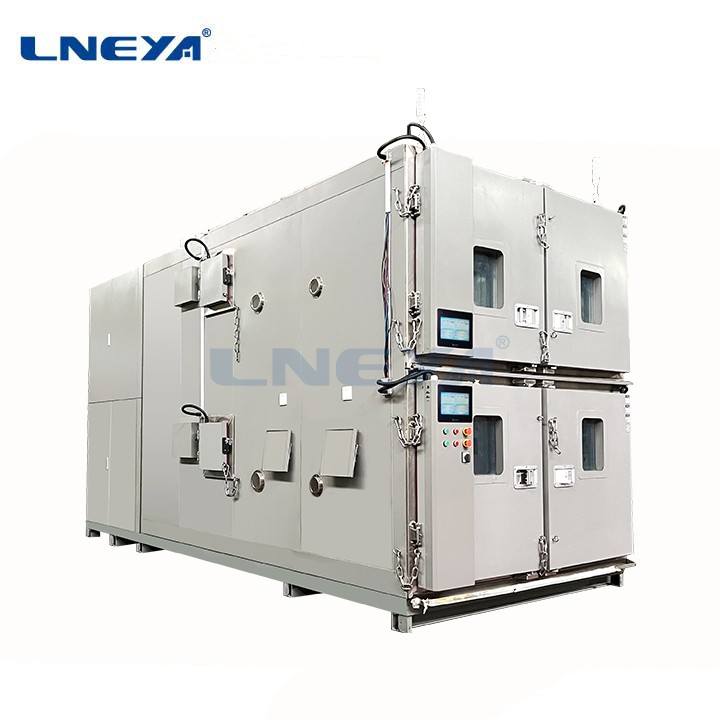왜 배터리에 동결 시험이 필요한가
도로에서 전기차가 늘어나고 있다는 것을 눈치채셨나요?
새로운 에너지 기술의 발전과 환경 의식의 향상으로 배터리 전동 차량은 이제 일상에서 흔히 볼 수 있는 모습입니다. 겨울에 전기차가 왜 더 천천히 충전되고 더 빨리 방전되는지 궁금한 적이 있나요? 이것이 배터리 수명에 영향을 미칠까요? 왜 일부 전기차는 -20℃ 환경에서도 안정적인 성능을 발휘할 수 있나요?
이는 연구 개발의 중요한 단계인 배터리 저온 테스트와 밀접한 관련이 있습니다. 배터리 저온 테스트란 무엇인가요? 왜 이 테스트를 하나요? 배터리가 얼었을 때 무슨 일이 일어날까요? 동결 테스트는 어떻게 진행되나요? 이 기사는 배터리 테스트의 미스터리를 밝혀드립니다.
왜 배터리를 얼게 하나요?
배터리 동결 테스트는 실제 사용 중에 encountered할 수 있는 저온 환경을 시뮬레이션하는 것입니다. 북미, 북유럽, 러시아 등지에서는 겨울철 온도가 매우 낮아 전기차가 시동을 거는 데 어려움이 있을 수 있습니다. 콜드체인 운송 장비와 일부 극지 탐사 장비에서는 저온으로 인해 배터리 시스템이 고장 나거나 심지어 단락될 수 있습니다.
이러한 문제가 사용 중에 발생하지 않도록 연구 개발 인원은 저온에서의 성능을 미리 파악해야 합니다. 재료의 내한성, 배터리의 서비스 수명, 내부 화학 반응 및 저온 임계값을 평가해야 합니다.

배터리가 얼면 무엇이 일어날까요?
저온 환경에서 배터리는 어떻게 동작하나요? 주요 효과는 다음과 같습니다:
느린 충전
겨울철에 전기차를 충전할 때 완전히 충전되는 데 시간이 오래 걸리는 이유는 저온이 배터리의 충전 속도에 영향을 미치기 때문입니다. 저온에서는 전해질의 점도가 증가하고, 전해질 내 리튬 이온의 이동 저항이 증가하며, 배터리의 충전 효율이 감소합니다. 저온 환경에서 충전이 계속되면 리튬 금속 침착이 발생할 수 있으며, 이는 배터리를 손상시키고 심지어 열 폭주를 일으킬 수 있습니다.
가속된 방전
아마 겨울철에 전기차를 짧은 거리만 운전한 후 배터리 전력이 많이 떨어졌다는 것을 발견하셨을 것입니다. 배터리가 전력을 공급할 수 있는 이유는 내부에서 화학 반응이 일어나 화학 에너지를 전기 에너지로 변환하기 때문입니다. 배터리가 외부 회로에 연결되면, 리튬 이온은 음극에서 나와 외부 회로를 통해 양극에 도달하여 전류가 형성됩니다. 저온에서는 리튬 이온의 이동이 방해받고, 배터리의 내부 저항이 증가하며, 방전 시 전압이 낮아지고, 사용 가능한 전력이 줄어듭니다.
안전 위험
극저온에서 전해질이 결빙되거나 리튬이 부분적으로 침전되거나 심지어 구조적인 손상(팽창, 누수, 단락 등)이 발생할 수 있습니다. 움직이는 차량에서 이러한 문제에 직면하면 운전자와 승객의 생명 안전에 큰 위협이 됩니다.
다양한 저온에서의 배터리 성능
배터리는 다양한 저온 범위에서 성능이 다릅니다. 다양한 온도대에서 테스트를 수행하면 연구 개발 인원이 배터리 공식 최적화와 배터리 셀 포장의 안정성을 평가하는 데 도움이 됩니다.
| 온도 범위 | 배터리 성능 |
| 0℃ ~ -10℃ | 약간의 성능 저하, 여전히 작동 가능 |
| -10℃ ~ -20℃ | 눈에 띄는 용량 손실, 시작 전압 부족, 짧아진 방전 시간 |
| -20℃ ~ -40℃ | 대부분의 리튬 배터리는 제대로 작동하지 않습니다. 특별한 저온 배터리가 필요합니다. |
| -40℃ ~ -80℃ | 항공 우주, 군사 및 기타 혹독한 환경에서의 극한 시험 범위 |
배터리 동결 테스트 기준
배터리의 신뢰성을 검증하고 비교 및 인증을 용이하게 하기 위해 많은 국가와 지역에서 배터리 동결 테스트 기준을 제정했습니다.
IEC 62660
국제 전기기술 위원회는 2010년에 IEC 62660 표준을 발표했으며, 이는 전기차 전력 시스템에 사용되는 모든 리튬 이온 셀에 적용됩니다. 이 표준은 -20°C에서 배터리 용량 테스트, 전압 유지 테스트 및 사이클 수명 테스트를 수행해야 한다고 규정하고 있습니다. 배터리의 테스트 환경, 테스트 방법 및 자격 기준도 규정되어 있습니다.
UN 38.3
유엔 경제 사회 이사회는 1999년에 UN 38.3 표준을 발표했으며, 이 표준은 계속해서 업데이트되고 있습니다. 이 표준은 전 세계적으로 운송에 사용되는 모든 리튬 배터리 및 완성된 배터리 팩에 적용됩니다. 전기차, 모바일폰, 전동공구 등이 포함됩니다. 배터리는 -40°C±2°C에서 6시간 동안 보관한 후 +75°C±2°C에서 6시간 더 보관하며, 이 사이클을 5일 동안 10회 반복해야 합니다. 테스트 중에는 배터리가 누수, 팽창, 화재, 폭발 등의 현상이 없으며, 정격 전압 요건을 충족해야 합격으로 인정됩니다.
SAE J2929
자동차 엔지니어 협회(SAE)는 2008년에 SAE J2929를 발표하고 2020년에 개정했습니다. 이 표준은 미국에서 판매되는 전기 및 하이브리드 차량의 배터리 시스템에 적용됩니다. 배터리 시스템 전체에 대한 환경 시뮬레이션을 요구하며, 저온 작동, 저온 충전 및 저온 실패 모드를 포함합니다. 테스트 온도는 북미 겨울 온도를 시뮬레이션하기 위해 -30°C로 제어하는 것이 좋습니다.
NASA-STD-4009
미국 항공 우주국(NASA)은 2021년에 NASA-STD-4009를 개정했습니다. 이 표준은 우주선, 위성 및 심우주 탐사 장비용 배터리 시스템에 적용됩니다. 배터리 시스템의 기밀성, 열 제어 능력 및 전기화학적 안정성을 극저온에서 평가하기 위해 -60°C 또는 그 이하에서 테스트해야 합니다.
GB/T 31467
중국 시장 규제 국가 행정국은 2015년에 GB/T 31467을 발표했습니다. 이 표준은 전기차용 리튬 이온 전력 배터리 시스템에 적용됩니다. 배터리는 -20°C에서 용량, 출력, 충전 및 방전 성능 테스트를 수행해야 하며, 테스트 방법 및 온도 제어 상자 오차(±2°C)가 명시되어 있습니다.
| 표준 이름 | 국가/조직 | 온도 요구 사항 | Main Application | Release Year |
| IEC 62660 | International / IEC | -20℃ | Performance and safety testing of EV single cells | Since 2010 |
| UN 38.3 | United Nations / UNECE | -40℃ cycling | Transportation adaptability and safety testing of batteries | Since 1999 |
| GB/T 31467 | 중국 | -20℃ | Performance and safety testing of EV battery packs | Since 2015 |
| SAE J2929 | USA / SAE | -30℃ | Safety and performance of battery pack systems | Since 2008 |
| NASA-STD-4009 | USA / NASA | -60℃ and below | Special battery testing for aerospace applications | 2021 Edition |
배터리 동결 시험은 어떻게 수행되나요?
다음은 배터리 동결 시험의 기본 절차와 주의사항입니다.
샘플을 준비하십시오.
대표적인 셀과 배터리 팩을 선택하고, 샘플을 꼼꼼히 검사하여 팽창이나 누출과 같은 명백한 결함이 없는지 확인해야 합니다.
Record the initial state
For the convenience of comparison, record the initial voltage, resistance, state of charge and other data of the battery. If you want to perform a cycle test, you also need to record the data of the last test.
Set a low temperature environment
According to the corresponding test standards, set the target temperature on the touch screen of the battery test box, which is generally -20 and -40℃. If it is a battery used for aviation, it needs to be set to about -70℃. To avoid thermal shock, you need to set a reasonable cooling rate.
Slow cooling
Place the battery in the test box and close the door, ensuring even thermal conduction through the sample holder. Wait for the temperature in the environmental test box to drop to the target temperature. Avoid frequent opening and closing of the box door during this process.
Maintain constant temperature
After reaching the target temperature, the sample needs to be placed in a constant temperature environment for at least 6 hours according to the requirements of the standard. During this period, the temperature fluctuation curve needs to be recorded to keep the temperature uniformity within ±2℃.
Testing
Perform discharge test, charge test and cycle test under low temperature conditions. Record battery capacity, voltage, internal resistance, discharge rate and other data. Compare with parameters at room temperature.
난방
After the test, slowly warm the battery to room temperature. It should be noted that the battery do not expose it directly to ambient room temperature, which will cause condensation or thermal stress damage. Then perform a safety check on the battery to check for bulging, leakage and other problems.
Note
• Make sure that the sample battery has no obvious damage
• Do not charge at extremely low temperatures
• Before discharging, it is necessary to maintain a constant temperature for a long enough time to avoid uneven cooling of the battery cell
• Someone must be present during the test
Performance of different types of batteries in freezing tests
Different types of batteries have different performance and behave differently in low temperature environments.
| Battery Type | Low-Temperature Characteristics |
| Ternary Lithium Battery | High energy density but poor low-temp performance; fast capacity fade; suitable for temperate climates |
| Lithium Iron Phosphate (LFP) Battery | High safety, better low-temp performance; can discharge at -20℃, but has lower energy density |
| Solid-State Battery | New battery technology with good low-temp stability; commercialization is still in progress |
| Nickel-Metal Hydride (NiMH) Battery | Significant capacity loss at low temperatures; suitable for low-power devices |
| Sodium-Ion Battery | Under development; early data shows better low-temp performance than traditional lithium batteries |
How to choose a battery test chamber?
If you buy a battery chamber for the purpose of testing electric vehicle batteries, how should you choose? You need to consider the following factors:
| Item | 설명 |
| 온도 범위 | Recommended: -70℃ to +100℃ (covers extreme environments) |
| 온도 제어 정확도 | At least ±0.5℃ (depending on testing standard) |
| Temperature Uniformity | ≤±2℃ to ensure consistent data for multiple battery samples |
| Cooling Rate | Recommended ≥1℃/min; some standards require ≥5℃/min |
| Data Logging | Should automatically record temperature, voltage, time, and other test data |
| Compatibility | Supports battery testers, communication interfaces, gas monitoring modules, etc. |
| Safety System | Equipped with over-temp alarm, power failure protection, leakage detection, etc. |
| After-sales & Customization | Supports customization, fast delivery, and technical consultation |
결론
Battery testing is necessary to ensure the safety of equipment and personnel. Generally, specially designed battery test chambers are used to simulate real-world application environments to test the performance of batteries at different temperatures. If you are looking for a reliable battery test chamber manufacturer, LNEYA is happy to provide you with customized solutions and technical support.
오늘 LNEYA에 연락하여 귀하의 특정 요구에 맞게 맞춤화된 배터리 테스트 챔버 전체 범위를 살펴보세요.
관련 냉각기
문의하기
TEL:전화
이메일: 이메일
위챗 및 왓츠앱:

Wechat QR

문의 사항이 있으시거나 견적이 필요하신가요? 아래 양식을 작성해 주시면 저희 팀이 24시간 이내에 답변해 드리겠습니다.
 LNEYA 산업용 냉각기 제조업체 공급 업체
LNEYA 산업용 냉각기 제조업체 공급 업체














